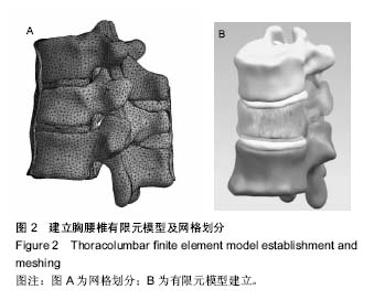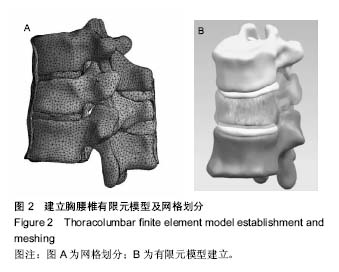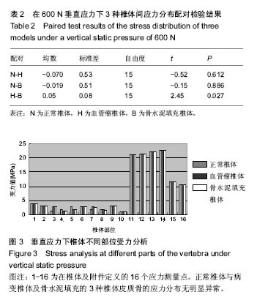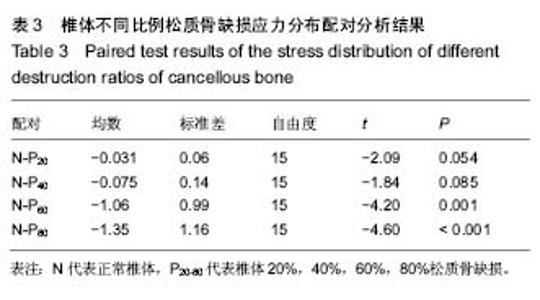| [1] 李健,黄海,张亮,等.经皮椎体成形术治疗症状性颈椎血管瘤1例[J].中国微创外科杂志,2011,11(12):1143-1144.[2] 万宁军,胡永成,王晗.椎板减压联合椎体成形术治疗合并脊髓功能损害的脊椎血管瘤[J].中华骨科杂志,2012,32(11):1001-1004.[3] 姜万荣,李兵,朱锡旭.射波刀治疗复发性椎体血管瘤1例报告及文献复习[J].现代肿瘤医学,2012,20(5):1034-1036.[4] 林松青,王彬,张磊,等.有限元分析在骨科中的应用及研究进展[J].中国中医骨伤科杂志,2013,21(4): 69-73.[5] 梁得华,鲁世保.有限元分析法在胸腰段脊柱骨折的应用进展[J].北京医学,2016,38(7):706-708.[6] 张振军,李阳,廖振华,等.有限元法在腰椎生物力学应用中的研究进展和展望[J].生物医学工程杂志,2016,33(6):1097-1202[7] 王海羽,王挺.有限元法分析全膝关节置换对胫骨近端骨重建的影响[J].中国组织工程研究,2016,20(35):5180-5186.[8] 张海峰,尹爱华,董毅,等.有限元法分析不同负荷下髋臼区的应力分布[J].中国组织工程研究,2016,20(39):5867-5872.[9] Zauel R, Yeni YN, Bay BK, et al. Comparison of the linear finite element prediction of deformation and strain of human cancellous bone to 3D digital volume correlation measurements. J Biomech Eng. 2006;128(1):1-6..[10] 李大森,郭卫,杨荣利,等.症状性脊椎血管瘤的术式选择和疗效分析[J]中国脊柱脊髓杂志,2015,25(2):97-102.[11] 杨保家,杨开舜,姚汝斌.影像及生物力学测试尼古丁剂量与腰椎后外侧植骨融合率的相关性[J].中国组织工程研究, 2016,20(48): 7251-7260.[12] 沈彬,孟阳,赵卫东,等.症状性椎体血管瘤影像学表现及手术治[J]中国脊柱脊髓杂志,2013,23(3):251-256[13] Cohen JE,Lylyk P,Ceratto R,et al.Vertebroplasty: technique and results in 192 procedures.Neurol Res.2004;26(1): 41-49.[14] Peh WC G,Munk PL,Rashid F,et al.Percutaneous Vertebral Augmentation: Vertebroplasty,Kyphoplasty and Skyphoplasty. Radiologic Clinics of North America,2008,46(3): 611-35,vii.[15] 姜亮,李杰,刘忠军,等.脊柱血管瘤的诊断与治疗[J]中国脊柱脊髓杂志,2011,21(1):38-54.[16] Fei Q,Zhao F,Yang Y,et al.[Effects of posterior lumbar spinal fusion on the stability of unstable lumbar segment and biomechanical properties of adjacent segments: a finite element study. Zhonghua Yi Xue Za Zhi.2015;95(45):3681.[17] Su Y,Ren D,Jiang M,et al.T1 finite element model of Kümmell's disease shows changes in the vertebral stress distribution. Int J Clin Exp Med. 2015;8(11):20046-20055.[18] Yan L,Chang Z,Xu Z,et al.Biomechanical effects of bone cement volume on the endplates of augmented vertebral body: a three-dimensional finite element analysis[J].中华医学杂志:英文版,2014,127(1):79-84.[19] Erbulut DU,Zafarparandeh I,Hassan C R,et al.Determination of the biomechanical effect of an interspinous process device on implanted and adjacent lumbar spinal segments using a hybrid testing protocol: a finite-element study. J Neurosurg Spine. 2015;23(2):200-208.[20] Cao KD,Grimm MJ,Yang KH.Load sharing within a human lumbar vertebral body using the finite element method.Spine. 2001;26(12):253-260.[21] 王宇, 靳安民, 方国芳,等. 腰椎椎弓根螺钉系统断裂的三维有限元分析[J]. 中国组织工程研究, 2008, 12(48):9439-9442.[22] Crawford RP,Keaveny TM.Relationship between axial and bending behaviors of the human thoracolumbar vertebra. Spine. 2004;29(20):2248-2255.[23] 鲍春雨,刘晋浩.人体脊柱腰椎节段三维有限元模型的研究与分析[J].机械设计, 2009, 26(9):61-63.[24] Dall'Ara E,Schmidt R,Pahr D,et al.A nonlinear finite element model validation study based on a novel experimental technique for inducing anterior wedge-shape fractures in human vertebral bodies in vitro. J Biomech. 2010;43(12): 2374-2380.[25] Oktenoglu T, Erbulut DU, Kiapour A, et al. Pedicle screw-based posterior dynamic stabilisation of the lumbar spine: in vitro cadaver investigation and a finite element study. Comput Methods Biomech Biomed Engin. 2015;18(11): 1252-1261.[26] 刘治华,徐新伟,管文浩,等.腰椎有限元模型的建立与不同角度牵引条件下的仿真研究[J].郑州大学学报医学版, 2014(1): 119-122.[27] Iselin L D,Wahl P,Studer P,et al.Associated lesions in posterior wall acetabular fractures: not a valid predictor of failure.J Orthop Traumatol.2013;14(3):179-184. |





